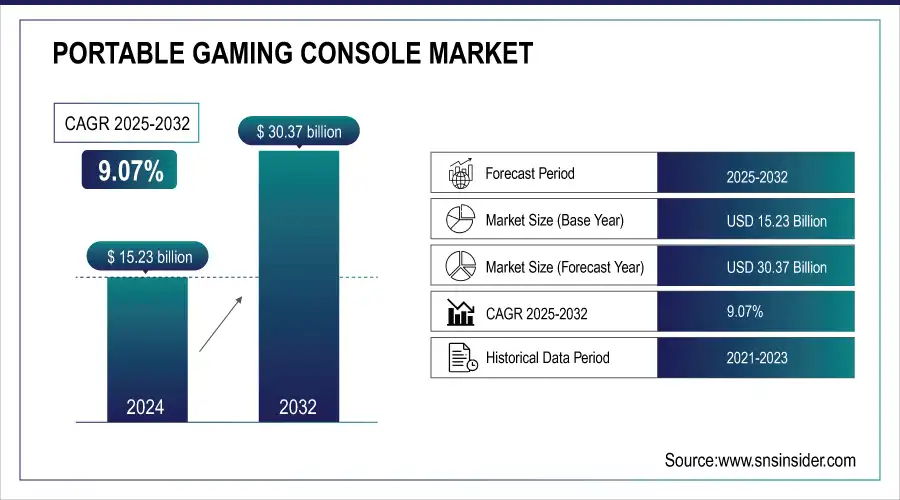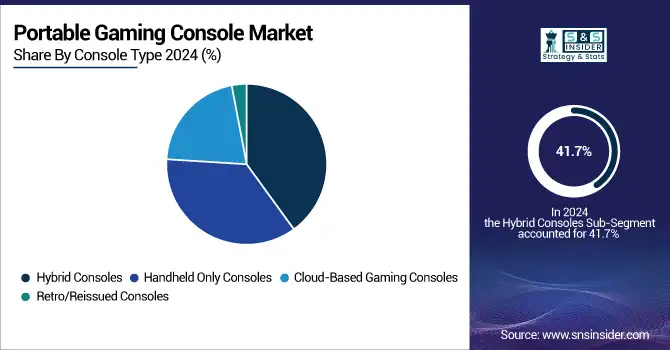Portable Gaming Console Market Size & Growth:
The Portable Gaming Console Market size was valued at USD 15.23 billion in 2024 and is expected to reach USD 30.37 billion by 2032, growing at a CAGR of 9.07% over the forecast period of 2025-2032. Portable Gaming Console Market trends are shifting toward hybrid and cloud-based devices, with growing demand for cross-platform compatibility and immersive gameplay. Shifting consumers trend towards durable gaming on the go, coupled with the compact size of advanced hardware performance and battery life is expected to drives the growth of Portable Gaming Console Market. Users stay hooked with its hybrid consoles, integration of cloud gaming services, and also, with an exhaustive game library. In addition, internet penetration as well as roll-out of 5G and digital distribution channels are several factors that further expected to support the market growth. In addition, it is driving the adoption across global consumer segments with young age groups, increasing disposable income and embracing multiplayer and social gaming experiences.

To Get more information on Portable Gaming Console Market - Request Free Sample Report
Steam Deck shipments reached between 3.7 to 4 million units globally by early 2025, confirming the strong demand for portable PC gaming.
The U.S. Portable Gaming Console Market size was valued at USD 3.95 billion in 2024 and is expected to reach USD 7.69 billion by 2032, growing at a CAGR of 8.75% over the forecast period of 2025-2032. The U.S. portable gaming market is expanding as demand for hybrid and handheld consoles (like the Switch and the Steam Deck), widespread 5G and broadband access, established digital game ecosystems, and greater engagement with more portable and on-the-go gameplay from younger, more digital-native generations continue to drive interest.

Portable Gaming Console Market Drivers:
-
Hybrid Consoles and Cloud Gaming Fuel Demand for High Performance Portable Gaming Experiences Worldwide
The increasing demand for flexible on-the-go gaming experience alongside improvements in hardware features such as high-performance processors, longer battery life, and advanced display technologies like OLED are some of the drivers for global portable gaming console market. The trend for hybrid console segment, enabling handheld and docked gameplay option, is driving the market growth as well. At the same time, the inclusion of cloud gaming services and online multiplayer capabilities massively boosted user engagement, along with the rising internet penetration and 5G rollout that stoked the flames for connectivity and performance expectations.
As of mid‑2025, 106 global providers offer mobile cloud gaming services, increasing accessibility on handheld consoles
Portable Gaming Console Market Restraints:
-
Battery Limitations and Heat Management Challenge Performance and Portability in Next Generation Gaming Consoles
Even with the most portable gaming consoles, the biggest dilemma is how battery performance deteriorates as hardware power requirements rise. High-end hardware such as GPUs, displays with high refresh rates, and better processors can also shorten the battery life of laptops, compromising the gaming experience when users are travelling or playing for long periods Thermal management is also still an issue due to the compact designs making it hard to dissipate heat for extended sessions, or when playing graphically intensive games.
Portable Gaming Console Market Opportunities:
-
Emerging Markets and Advanced Technologies Unlock New Growth Avenues for Portable Gaming Console Manufacturers Globally
Emerging markets with expanding youth populations and digital infrastructure offer untapped growth potential for portable gaming device manufacturers. Opportunities also lie in developing cross-platform compatibility, subscription-based cloud gaming models, and AI-enhanced gaming experiences that personalize gameplay, improve accessibility, and broaden consumer reach.
Over 95% of internet users in the Philippines played video games in 2023, most on mobile devices demonstrating the scalable potential of handheld consoles in demographics with strong youth penetration
Portable Gaming Console Market Challenges:
-
Fragmented Gaming Ecosystems and Component Shortages Challenge Innovation and Accessibility in Portable Console Market
Another restraint is the fragmentation of gaming ecosystems, where cross-platform compatibility and seamless game migration remain inconsistent across devices and publishers. Furthermore, supply chain disruptions and delays in critical component availability especially semiconductors can slow product innovation cycles. Lastly, digital rights management (DRM) and online authentication requirements can hinder accessibility in regions with unstable internet connections.
Portable Gaming Console Market Segmentation Analysis:
By Console Type
Hybrid consoles dominated the portable gaming console market in 2024, accounting for approximately 41.7% of total global demand. Their ability to function both as handheld and docked systems offers users unmatched flexibility, contributing to their widespread popularity. Devices like the Nintendo Switch and Valve Steam Deck have set industry benchmarks by combining powerful performance with seamless transition between portable and home gaming. Their versatility continues to appeal to a broad demographic from casual players to hardcore gamers.
Cloud-based gaming consoles are expected to witness the fastest CAGR from 2025 to 2032. The growth is driven by increasing 5G penetration, expanding cloud infrastructure, and rising demand for streaming-based, hardware-light gaming experiences that eliminate the need for frequent hardware upgrades.

By Connectivity
Wi-Fi enabled consoles held the dominant position in the portable gaming console market in 2024, capturing approximately 44.7% of the overall share. These devices offer reliable, high-speed internet access for downloading games, streaming content, and enabling online multiplayer functionality. Wi-Fi remains the most accessible and widely adopted connectivity option globally, making it the preferred choice among casual and dedicated gamers alike. The affordability of home and public Wi-Fi networks further supports their mass adoption.
During 2025 to 2032, cellular-enabled consoles (4G/5G) are projected to grow at the fastest CAGR. This growth is fueled by increasing 5G deployment, demand for uninterrupted gaming on the go, and expanding mobile network infrastructure, particularly in urban and developing markets.
By End User
In 2024, casual gamers accounted for the largest segment of the portable gaming console market, holding a dominant share of approximately 33.8%. Their preference for user-friendly interfaces, affordable pricing, and entertainment-oriented content drove this segment’s growth. Casual gamers typically seek convenience and quick play sessions, making portable consoles ideal for their lifestyle. The availability of diverse game genres, including puzzle, simulation, and adventure, further fuels engagement among this audience, particularly in urban and mobile-centric environments.
During 2025 to 2032, the 18–35+ adult age group is expected to witness the fastest CAGR. This demographic is increasingly adopting portable consoles for immersive, high-performance gaming experiences. Their strong purchasing power, tech-savviness, and interest in multiplayer and cross-platform gaming ecosystems contribute significantly to market expansion.
By Distribution Channel
Online platforms dominated the portable gaming console market share with a 58.2% in 2024 and are expected to grow at the fastest CAGR from 2025 to 2032. This growth is driven by the increasing preference for digital purchases, faster content delivery, and the convenience of accessing game libraries directly from home. The expansion of cloud gaming services, frequent digital promotions, and growing user trust in online payment systems are also boosting consumer adoption through e-commerce platforms and brand-owned digital storefronts.
Portable Gaming Console Market Regional Overview:
North America dominated the portable gaming console market in 2024, accounting for 34.3% of the global share. The region's leadership stems from its advanced digital infrastructure, high disposable income, and strong gaming culture. The widespread popularity of hybrid consoles, early adoption of cloud gaming, and a large base of tech-savvy consumers continue to support sustained demand. Moreover, strategic partnerships, frequent hardware innovations, and growing interest in mobile-first entertainment further contribute to North America's strong market presence.

Get Customized Report as per Your Business Requirement - Enquiry Now
The United States led the North American market in 2024, driven by robust consumer spending, early technology adoption, and a thriving ecosystem of developers, content creators, and cloud gaming service providers.
Asia Pacific is projected to witness the fastest CAGR in the portable gaming console market from 2025 to 2032. This growth is fueled by a rapidly expanding middle class, increasing smartphone and internet penetration, and a strong youth population with rising interest in gaming. Governments across the region are also investing in digital infrastructure, enhancing connectivity and mobile access. Additionally, the popularity of multiplayer and cloud-based gaming experiences is rising, especially in urban centers, driving further market expansion.
Japan dominated the Asia Pacific portable gaming console market in 2024, owing to its rich gaming heritage, leading console manufacturers, high-tech infrastructure, and strong consumer demand for hybrid and handheld devices.
Europe remains a significant region in the portable gaming console market, backed by a well-established gaming culture, strong consumer electronics penetration, and increasing adoption of hybrid consoles. The region benefits from widespread broadband access, rising demand for cross-platform and cloud gaming, and a growing number of indie game developers fueling content diversity. Additionally, eco-conscious consumer preferences are influencing demand for energy-efficient devices. Countries like Germany, the UK, and France lead regional sales, supported by digital retail channels and tech-savvy gaming communities.
Latin America and the Middle East & Africa are emerging as promising markets for portable gaming consoles, driven by expanding youth populations, improving internet connectivity, and growing smartphone penetration. In Latin America, countries like Brazil and Mexico are witnessing increased demand due to rising urbanization and interest in mobile entertainment. Meanwhile, the Middle East & Africa region is gaining traction with a surge in digital infrastructure development, government support for tech innovation, and rising interest in e-sports and social gaming platforms.
Key Portable Gaming Console Companies are:
The Key Portable Gaming Console Market are Nintendo, Sony Interactive Entertainment, Valve, ASUS, Lenovo, AYN Technologies, Logitech G, Razer, GPD, One-Netbook, Anbernic, Powkiddy, AOKZOE, Retroid, Hyperkin, Playdate, Evercade, Tencent Games, Qualcomm, Alienware.
Recent Developments:
-
In January 2025, Nintendo officially revealed the Switch 2, showcasing its design, magnetic Joy‑Con 2 controllers, and introductory gameplay footage in a debut video.
-
In August 2024, Sony officially launched the PlayStation Portal Remote Player in India at ₹18,990 (~USD 200). The device allows streaming of PS4 and PS5 games over home Wi‑Fi on its 8‑inch 1080p LCD screen with DualSense haptic controls.
| Report Attributes | Details |
|---|---|
| Market Size in 2024 | USD 15.23 Billion |
| Market Size by 2032 | USD 30.37 Billion |
| CAGR | CAGR of 9.07% From 2025 to 2032 |
| Base Year | 2024 |
| Forecast Period | 2025-2032 |
| Historical Data | 2021-2023 |
| Report Scope & Coverage | Market Size, Segments Analysis, Competitive Landscape, Regional Analysis, DROC & SWOT Analysis, Forecast Outlook |
| Key Segments | • By Console Type (Handheld Only Consoles, Hybrid Consoles, Cloud-Based Gaming Consoles, and Retro/Reissued Consoles) • By Connectivity (Wi-Fi Enabled Consoles, Cellular-Enabled Consoles (4G/5G), Bluetooth Integration, and Offline/Standalone Consoles) • By End User (Casual Gamers, Hardcore/Professional Gamers, Children & Teenagers, and Adults (18–35+ Age Group)) • By Distribution Channel (Online Platforms, and Offline Channels) |
| Regional Analysis/Coverage | North America (US, Canada, Mexico), Europe (Germany, France, UK, Italy, Spain, Poland, Turkey, Rest of Europe), Asia Pacific (China, India, Japan, South Korea, Singapore, Australia, Taiwan, Rest of Asia Pacific), Middle East & Africa (UAE, Saudi Arabia, Qatar, South Africa, Rest of Middle East & Africa), Latin America (Brazil, Argentina, Rest of Latin America) |
| Company Profiles | Nintendo, Sony Interactive Entertainment, Valve, ASUS, Lenovo, AYN Technologies, Logitech G, Razer, GPD, One-Netbook, Anbernic, Powkiddy, AOKZOE, Retroid, Hyperkin, Playdate, Evercade, Tencent Games, Qualcomm, Alienware. |

